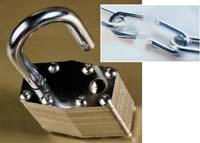Quantum cryptography to ensure privacy

Every time you use the cash card to pay for a purchase, to make the transaction safe, the card code and all banking information is encrypted. The user of the computer accessing on his own also uses the code. Company technicians send messages to each other and do not want the competition to know what they work on. Scientists, for their part, keep their research under lock until they are willing to publish them, but at the same time give their collaborators access to the computer where they store the information so they can consult it. All this through computer programs that encrypt the information.
Cryptography, therefore, is around everyone. But despite this, we do not use it naturally. It is true that we have a user code to access the computer, but we send unencrypted messages over the Internet. However, with current technology it is not possible to observe all the information traffic that circulates on the Internet.
Computer algorithms
There are currently secure algorithms for message encryption. Well, those algorithms in theory are not safe, but in practice they are. That is, theoretically there is a way to decipher those encoded messages, but the technology needed for it and the computing force are not available. In fact, all current cryptography systems are based on the same principle, that is, a system is secure, although all computers in the world work at once, they need as much time as the universe to decrypt a single message.

However, there is another model of cryptography, called quantum cryptography, which does not depend on the computational force of current computers. This model of cryptography, based on particle physics, is a concept developed together with quantum computers.
Unlike the cryptography systems currently used, quantum cryptography is itself secure, that is, there is no physical way to decrypt a message encoded by quantum cryptography. And it is not a theoretical concept, but a technology that is being developed every day.
But if current cryptography systems offer the necessary security, why is it necessary to develop quantum cryptography? Isn't it wasting time and money? Well, no. If at some point they build a quantum computer, it will leave all current computers qualitatively behind and thereby render useless all current cryptography systems.
Quantum computers
Current computers use bits to perform basic calculations. The bit is a binary arithmetic digit with two possible values, 0 and 1. Using bits, a conventional computer performs sequential calculations. Perform one calculation and then another.

Conversely, a quantum computer does not use conventional bits, but quantum bits, and quantum bits have a very different behavior. The properties of particles are used to define quantum bits, acting according to the uncertainty principle of Heissenberg.
Although it seems incredible, a quantum bit simultaneously takes values 0 and 1, so the quantum computer does not perform the calculations sequentially but simultaneously. And if that were not enough, the number of calculations that a quantum computer can perform simultaneously increases exponentially with respect to the number of bits. That is, a quantum bit can perform two operations simultaneously, but 2 quantum bits will perform 4 operations, 5 quantum bits will perform 32 operations and 20 quantum bits will carry more than one million. Simultaneously.
Photon Physics
With this very high computation speed, quantum computers would perform for a reasonable time the calculations that conventional computers would perform in eternity, which would render useless the current cryptography systems. So, if we assume that this revolutionary computer is a reality, how can we get the information to be saved and transmitted safely? Well, if the force of quantum computer is based on quantum theory, it is logical to think that quantum theory itself will allow to create a safe cryptography model.
This cryptography model is called quantum cryptography and the experiments that have been done so far are based on photons. Photons have the property that is called vibration angle, that is, vibrate in a certain direction.

White light produces photons that vibrate in all directions, but through a polaroid filter photons with a certain vibration angle can be selected. In this way a sequence of photons can be obtained in which photons have predetermined vibration angles. However, if an eyepiece wants to find this sequence, it should first measure the vibration angle of the photons, and this measurement necessarily implies a change in the vibration angle of the photon itself. That is, whoever wants to intercept a message that does not correspond to himself, would receive wrong information and the recipient of the message would realize that someone has read that information.
Within the limits of quantum theory, both the problem of storing and transmitting information safely and the solution of this problem are found. The quantum computer leaves the current cryptography unused, but at the same time it offers quantum cryptography, physically unspeakable.
Advancing
The first experiment on quantum cryptography was conducted by Charles Bennett almost 20 years ago. In 1988 he managed to communicate two computers located 30 centimeters away by means of a photon transmission. As mentioned, a small interaction can modify the vibration angle of the photon, so the first transmissions were made in airtight media.
In 1995, a 23-kilometer-long optical fiber was used, from Geneva to Nyon, for photon encrypted communication. However, in the future, the aim of the researchers is to carry out satellite communications through the transmission of photons. On this road, at the American research center Los Alamos, they have carried out an aerial transmission of photons of one kilometer.

All of these experiments make it clear that quantum cryptography is developing and scientists expect this cryptography to be available for the creation of quantum computers.
Codes and cryptography systems have evolved a lot and those they used trusted those figures, but time has shown that all the figures have their poplars. Quantum cryptography is still considered impossible to decipher, since its decryption would mean, among other things, that quantum theory is defective. But who knows what the future holds.






